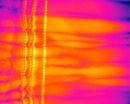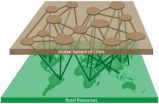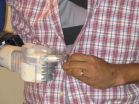(Press-News.org) CLEVELAND – A first-of-its-kind clinical trial conducted at University Hospitals (UH) Case Medical Center Seidman Cancer Center has shown encouraging results for the use of stereotactic radiosurgery to treat kidney cancer. This non-invasive treatment technique may represent a potential new non-surgical option for patients with this deadly disease who have limited treatment options.
Rod Ellis, MD, lead author of the study along with Lee Ponsky, MD, who is the Principal Investigator, presented results of a Phase 1 clinical trial in 20 patients with localized primary renal cancer at the 54th Annual Meeting of the American Society for Radiation Oncology (ASTRO) in Boston. In the abstract titled "Stereotactic Radiosurgery for Renal Cancer: Phase I Safety and Toxicity" (embargoed Oct. 31, 7:00 am ET), Dr. Ellis presented data that 94 percent of patients treated in the study had decreased or stable disease, with limited side effects.
"This trial shows that low to moderate doses of stereotactic radiosurgery are safe for renal cancer patients who typically do not have surgical options," said Dr. Ellis, Clinical Director and Vice Chair for Clinical Affairs, Department of Radiation Oncology at UH Case Medical Center and Associate Professor of Radiation Oncology and Urology at Case Western Reserve University School of Medicine. "Based on these findings, this treatment represents a promising therapeutic option. Further studies are needed to determine safe levels for the maximum dosage and by doing so, we hope to find increased response and cure rates with this method."
"This study is a unique partnership between a surgeon and radiation oncologist, intended to offer patients a non-invasive, highly focused ablative radiation with surgical precision with little to no side effects," said Dr. Ponsky, Director, Urologic Oncology and Minimally Invasive Therapies at UH Case Medial Center and Associate Professor of Urology at Case Western Reserve School of Medicine. "We are very excited about these results and cautiously optimistic about the future potential of this therapy."
According to the American Cancer Society, there are about 65,000 new cases of kidney cancer each year in the U.S. and it is among the 10 most common cancers in both men and women. Treatment options typically include surgery or cryoablation (using cold therapy to destroy the tumor).
However, many patients are not surgical candidates and stereotactic radiosurgery provides a noninvasive alternative in just three treatments which requires no anesthesia or narcotics. Stereotactic radiosurgery is performed using Cyberknife, a robotic radiosurgery system which delivers targeted doses of radiation with sub-millimeter accuracy while minimizing damage to surrounding healthy tissue. This high-dose, focused radiation destroys tumor cells and stops cancer cells from growing.
This study followed patients from two to 41 months post-treatment using a four-part dose escalation schema. The response rate indicates that patients reacted well and had acceptable levels of treatment-related toxicity following stereotactic radiosurgery in all age groups from 58 to 92 years old.
Based on these positive results, Drs. Ellis and Ponsky and a team of researchers have launched a follow-up phase two study for 12 additional patients with increased dosage to determine the most effective dosage. "This study builds upon our team's previous work as we continue to evaluate and define the role of radiosurgery for the safe and effective treatment of kidney tumors," said Dr. Ponsky, who holds the Leo and Charlotte Goldberg Chair in Advanced Surgical Therapies.
"Radiosurgery delivers a higher and more effective dose directly to the tumor site with less side effects than conventional radiation and has been very effective in treating other hard-to-reach tumors," said Dr. Ellis. "We are excited about its potential for kidney cancer patients and to be able to offer a non-invasive option."
###
Study co-authors include R.B. Patel, C. Kunos, Y. Zhang, J. Brindle, V. Kudithipudi, and D.A. Kaminsky. Trial funded by the Accuray Corporation, Sunnyvale, California.
About University Hospitals
University Hospitals serves the needs of patients through an integrated network of hospitals, outpatient centers and primary care physicians. At the core of our health system is University Hospitals Case Medical Center. The primary affiliate of Case Western Reserve University School of Medicine, University Hospitals Case Medical Center is home to some of the most prestigious clinical and research centers of excellence in the nation and the world, including cancer, pediatrics, women's health, orthopedics and spine, radiology and radiation oncology, neurosurgery and neuroscience, cardiology and cardiovascular surgery, organ transplantation and human genetics. Its main campus includes the internationally celebrated UH Rainbow Babies & Children's Hospital, ranked among the top children's hospitals in the nation; UH MacDonald Women's Hospital, Ohio's only hospital for women; and UH Seidman Cancer Center, part of the NCI-designated Case Comprehensive Cancer Center at Case Western Reserve University. University Hospitals Case Medical Center is the 2012 recipient of the American Hospital Association – McKesson Quest for Quality Prize for its leadership and innovation in quality improvement and safety.
For more information, go to www.uhhospitals.org
Stereotactic radiosurgery shows promise for kidney cancer
Data presented by University Hospitals Case Medical Center researchers at ASTRO
2012-10-31
ELSE PRESS RELEASES FROM THIS DATE:
Privately owned genetic databases may hinder diagnosis and bar the way to the arrival of personalized medicine
2012-10-31
In response to the on-line publication by the European Journal of Human Genetics today (Wednesday) of an article by US researchers led by Dr. Robert Cook-Degan, a former member of the US Office of Technology Assessment, showing that Myriad Genetics, providers of the BRCA1/2 genetic test in the US, has amassed vast quantities of clinical data without sharing it, Professor Martina Cornel, chair of the European Society of Human Genetics' Professional and Public Policy committee, said:
"We are very concerned that such important data is being withheld from those who most need ...
Obese dogs at risk of health condition experienced by humans
2012-10-31
Veterinary scientists at the University of Liverpool have found that, like humans, obese dogs can experience metabolic syndrome, a condition that describes multiple health issues that occur in the body at the same time.
The condition occurs when a number of health problems, such as increased blood glucose and increased cholesterol levels, develop together, with the potential to increase the risk of other diseases, such as cardiovascular disease and diabetes.
Although canine obesity is known to cause insulin resistance, mild hypertension, and high blood cholesterol ...
Health inequalities could be reduced by more effective health care, says new study
2012-10-31
Wide differences in death rates from disease still persist throughout England – but effective healthcare can help to reduce these inequalities, a new study has discovered.
Researchers from the University of Leicester led a two-year project funded by the National Institute for Health Research (NIHR) into why differences in death rates from diseases like heart disease, strokes, lung disease and cancers still persist.
They found that age and poverty were among the biggest factors that accounted for the differences – but they also discovered that effective delivery of healthcare ...
Navy oceanographers delve deeper in wave data to improve forecasts
2012-10-31
WASHINGTON--Around the globe, mariners and navies alike have long observed and included weather and sea states in navigational planning when plotting course or developing military strategy. And although forecasting had become an integral function by the start of the 20th century, these predictions were often crude and qualitative.
For the U.S. Navy, the years 1941 through 1946 provided an unusual stimulus to ocean wave research, according to pioneer World War II oceanographer Charles Bates. During this brief five-year period, theory, observation, and prediction of sea, ...
Sustainable cities must look beyond city limits
2012-10-31
City leaders aspiring to transform their cities into models of sustainability must look beyond city limits and include in their calculation the global flow of goods and materials into their realm, argue researchers in the Royal Swedish Academy of Sciences journal Ambio.
Many cities are now developing sustainable strategies to reduce pollution and congestion, improve the quality of life of their citizens, and respond to growing concern about human impact on climate and the environment. But sustainable city initiatives often ignore the environmental footprint from imported ...
New metric to track prosthetic arm progress
2012-10-31
PROVIDENCE, R.I. [Brown University] — Amputees with a new prosthetic arm must learn how to use their device to perform everyday tasks that were once second nature. Taking off a shirt becomes a conscious, multistep effort: grasp the shirt, lift the shirt over the head, pull arms through the sleeves, place the shirt on the table, let go of the shirt.
In the best cases of treatment, patients work with teams of doctors, prosthetists, and therapists to learn how their new limbs can help them regain function and quality of life. But clinicians have had few tools to assess ...
New hope for survivors of stroke and traumatic brain injury
2012-10-31
A new ground-breaking study about to be published in the Adis journal CNS Drugs provides clinical evidence that, for the first time, chronic neurological dysfunction from stroke or traumatic brain injury can rapidly improve following a single dose of a drug that targets brain inflammation, even years after the stroke or traumatic event.
The observational study¹ of 629 patients, conducted over the course of nearly two years, documents a diverse range of positive effects, including statistically significant rapid clinical improvement in motor impairment, spasticity, cognition, ...
Graphene mini-lab
2012-10-31
A team of physicists from Europe and South Africa showed that electrons moving randomly in graphene can mimic the dynamics of particles such as cosmic rays, despite travelling at a fraction of their speed, in a paper about to be published in EPJ B.
Andrey Pototsky and colleagues made use of their knowledge of graphene, which is made of a carbon layer, one atom thick, and packed in a honeycomb lattice pattern. In such material the interaction of electrons with atoms changes the effective mass of the electrons. As a result, the energy of electrons in graphene becomes similar ...
First-ever 3-D stress map of developing embryonic heart sheds light on why defects form
2012-10-31
WASHINGTON, Oct. 31—As a human fetus develops, its heart has to keep pace with the new body's ever-growing demands. Much of this is controlled by following genetic blueprints, but the embryonic heart also matures in response to the intense stresses of pumping blood. For the first time, researchers have been able to visualize in 3-D the stresses induced by flowing blood in an embryonic heart. The technique, which promises to provide new insight into how and why heart defects develop, is described in a paper published today in the Optical Society's (OSA) open-access journal ...
Unlocking the secrets of DNA repair
2012-10-31
Scientists from the University of Sheffield have unlocked one of the secrets to DNA repair –helping doctors identify DNA base damage and a patient's susceptibility to certain types of cancer.
Groundbreaking research led by Dr David Williams from the University of Sheffield's Department of Chemistry and an international collaboration of expert researchers has discovered how some proteins recognise damaged bases within DNA which, if untreated, could lead to cancer.
Dr Williams said: "Proteins carry out all the day-to-day processes needed for survival. If the DNA bases ...
LAST 30 PRESS RELEASES:
World-first discovery uncovers how glioblastoma tumours dodge chemotherapy, potentially opening the door to new treatments
A fatal mix-up: How certain gut bacteria drive multiple sclerosis
New AI tool identifies not just genetic mutations, but the diseases they may cause
Deep-learning model predicts how fruit flies form, cell by cell
Combination pills for high blood pressure may simplify treatment, improve long-term health
Immune system keeps mucosal fungi in check
Neurons within the brain use simple rules to localize genetic messages
Electrodes created using light
Second-hand gift-giving is a well-deliberated decision
How human interaction drove evolution to make bears less aggressive
National Poll: Few parents offer teens guidance on healthy eating during holiday season
Cannabis derivatives could provide new ovarian cancer treatments
Raising strong yeast as a petroleum substitute
Clues to the origin of hot Jupiters hidden in their orbits
Canada’s reduced pledge to Global Fund will impact domestic health
1 in 4 children with major traumatic injuries not cared for in pediatric trauma centres
Duke and Duke-NUS’ joint cross-population research to uncover "East-West" differences in disease and care
Scientists to ‘spy’ on cancer- immune cell interactions using quantum technology breakthrough
Tech savvy users have most digital concerns
Making lighter work of calculating fluid and heat flow
Normalizing blood sugar can halve heart attack risk
Lowering blood sugar cuts heart attack risk in people with prediabetes
Study links genetic variants to risk of blinding eye disease in premature infants
Non-opioid ‘pain sponge’ therapy halts cartilage degeneration and relieves chronic pain
AI can pick up cultural values by mimicking how kids learn
China’s ecological redlines offer fast track to 30 x 30 global conservation goal
Invisible indoor threats: emerging household contaminants and their growing risks to human health
Adding antibody treatment to chemo boosts outcomes for children with rare cancer
Germline pathogenic variants among women without a history of breast cancer
Tanning beds triple melanoma risk, potentially causing broad DNA damage
[Press-News.org] Stereotactic radiosurgery shows promise for kidney cancerData presented by University Hospitals Case Medical Center researchers at ASTRO



